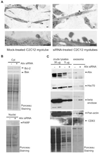Identification and characterization of the nano-sized vesicles released by muscle cells
- PMID: 23523921
- PMCID: PMC4714929
- DOI: 10.1016/j.febslet.2013.03.012
Identification and characterization of the nano-sized vesicles released by muscle cells
Abstract
Several cell types secrete small membranous vesicles that contain cell-specific collections of proteins, lipids, and genetic material. The function of these vesicles is to allow cell-to-cell signaling and the horizontal transfer of their cargo molecules. Here, we demonstrate that muscle cells secrete nano-sized vesicles and that their release increases during muscle differentiation. Analysis of these nanovesicles allowed us to characterize them as exosome-like particles and to define the potential role of the multifunctional protein Alix in their biogenesis.
Copyright © 2013 Federation of European Biochemical Societies. All rights reserved.
Figures



References
-
- Simons M, Raposo G. Exosomes--vesicular carriers for intercellular communication. Curr Opin Cell Biol. 2009;21:575–581. - PubMed
-
- Guescini M, Guidolin D, Vallorani L, Casadei L, Gioacchini AM, Tibollo P, Battistelli M, Falcieri E, Battistin L, Agnati LF, Stocchi V. C2C12 myoblasts release micro-vesicles containing mtDNA and proteins involved in signal transduction. Exp Cell Res. 2010;316:1977–1984. - PubMed
-
- Odorizzi G. The multiple personalities of Alix. J Cell Sci. 2006;119:3025–3032. - PubMed
Publication types
MeSH terms
Substances
Grants and funding
LinkOut - more resources
Full Text Sources
Other Literature Sources
Molecular Biology Databases
Miscellaneous

